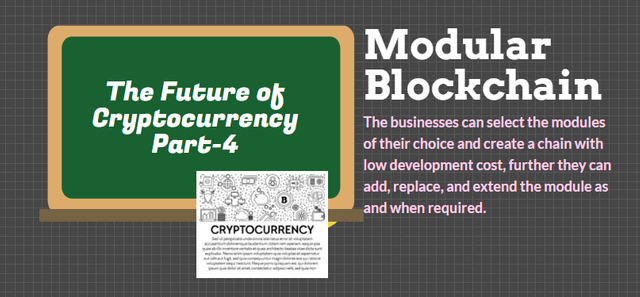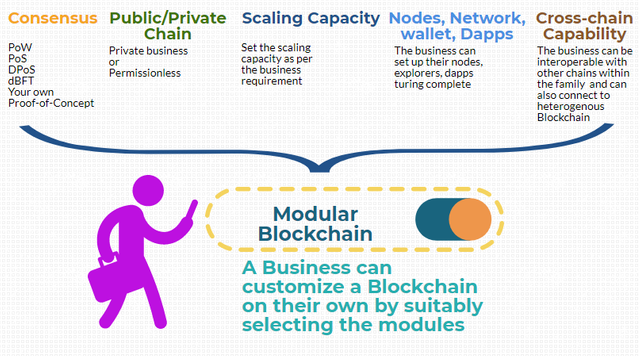The Future of Cryptocurrency: Part4


In the ongoing week of #steemcryptochallenge, I have covered Part 1 Part2 and Part 3 of The Future of Cryptocurrency to explore different areas where The Future of Cryptocurrency can excel. But that is mostly outer space.
In today's publication, we will see why and how the inner space of the Blockchain technology needs to be more flexible to attract businesses to adopt this technology and make it easy for all.

Customizable Blockchain
With the advent of Blockchain technology, we get off to a start with Store-of-value (BTC) in 2009, then Smart Contract(Etherum) in 2013/14, then high-performance blockchain- scalable Blockchain (EOS/Tron) in 2017, etc.
What next with the evolution of Blockchain technology?
Every commercial Blockchain has its own use-case, they tend to create an ecosystem and invite businesses to use their infrastructure.
But the point is that-- is there any Blockchain which is the best fit for most of the businesses/enterprises? That's really difficult to say.
For businesses/enterprises, the associated costs and trade-offs are always considered. The predominant criteria to serve the business most of the time determines the business direction.
In Blockchain technology, the general nomenclature we come across are-- Consensus, Permissionless/Permissioned, Scalability, Wallet, Explorer, Smart Contract, Interoperability, etc.
A business may be happy with your consensus but may not be with scalability, it might also want to make it a private sub-chain. The customizable option of creating a Blockchain is not available for businesses/enterprises.
The businesses/enterprises do not have the flexibility to build their businesses like a modular home. They do not have the option to assemble the prefabricated pieces/modules of their choice when they go with Blockchain solutions.
Hence the Future of cryptocurrency going forward needs to be Modular. With Modular Blockchain, the businesses will find it easy and will have more flexibility to select the best modules to suit their business and then create a Blockchain on their own.
Further, the developer thing is a little high barrier to entry for most of the businesses, the businesses always look for low development cost and even when they go for assembly it should not be a high-end job for them.
There should be a chain factory with the ready-made modules(which can be added, extended, replaced in the future). Depending on the different parameters & requirements of the enterprises, the suitable ready-made modules must be selected from the Factory and then it will be assembled together to create a customized chain to cater to their business requirement.
The future of cryptocurrency going forward is going to be more modular, which will also bring mass adoption to this domain. Enterprise-grade solutions are essential for long term sustainability and that will also induce strong fundamental value to the crypto ecosystem.
The ecosystem should also offer flexibility to code with different programming languages, making it interoperable with each other.
There are various components of a Blockchain, and you break it into different components, so as to create modules for the enterprises, For example, ledger, storage, smart contract, account, consensus, etc. Since you break it into different modules, it should also ensure the flexible coupling of one module with the other. It may so happen that coding language may result in the tight coupling, and that does not make customization easy. So flexible coupling between modules is also essential for customizable Blockchain. For that, it must support multi-lingual programming.
Innovation and Evolution of technology are very fast in modern days. What you are using today may become obsolete tomorrow. For businesses, there is a considerable amount of cost associated when they go for complete upgradation, therefore the existing technology must offer the replaceability, extendability of the various modules they use in their Blockchain.
The modularity of Blockchain must also offer multi-language coding support so that the coupling between different modules become more flexible.
Example,
Consensus- PoW, PoS, DPoS, dBFT, PoC, or your own Proof-of-Concept
Private Chain/Public Chain
Dapps
Explorer
Wallet
Cross-chain and multi-chain capabilities
Interoperability
In the existing commercial Blockchains, when you chose a particular Blockchain, you are bound to choose every other component/feature by default. Suppose you go with Etherum, then you accept their low scalability, you accept their consensus and other things.
So you don't have the flexibility to choose a consensus of your choice, or to make it a private/public chain, etc.
In customization, let's say you love the scaling capacity of Tron Blockchain, but you want to have PoW of Bitcoin Blockchain. So if the modular components of both the chains are available, then you can customize a Blockchain with Consensus of Tron and with the PoW of BTC. (This is an example only).

In modular Blockchains, you are free to choose any components of your choice(that you think the best fit for your business requirement) and then you assemble together, create your own chain, then in the application layer your deploy your dapp.
Further, you can also add, replace, and extend any module, as when your business demands for it.
You can create your own stable coin, you can also enhance cross-chain capabilities with other business(other chains), you can connect to chains like Bitcoin or Etehrum chain.
You can set your own rule in the Blockchain, accordingly select the modules and customize your chain. The high development costs can also be minimized as you get ready-made modules of Layer "0".
So modularity, better interoperability, flexibility, etc are going to be the future of Cryptocurrency.

Conclusion
For both enterprises and retail needs, a more and more modular Blockchain environment is necessary. If any Blockchain has been working in this direction, then it is NULS.
We should not judge the potential and worth of a Blockchain by the price of its native coin. NULS price may not be that high as it supposed to be, but I really see tremendous potential in this coin for mass adoption to make a Blockchain a dynamic thing, a customizable thing, a modular thing.
The outer space(the market) needs to be explored for mass adoption and to ensure a better future of Blockchain technology but at the same time, the inner space(the technology itself) needs to be made modular to allow the businesses/enterprises/retailers to customize a chain on their own(without high development cost/knowledge).
Thank you.

Cc:-
@steemitblog
@steemcurator01
@steemcurator02


The whole concept of a modular blockchain is great. But individual businesses might not need blockchains of their own.
I still feel that the development barrier would still exist even in modular blockchains. For example, if a new business adopts a modular blockchain, there would still be the need to develop smart contracts that would suit the business needs.
Instead using a blockchain that is already available that supports smart contracts like Ethereum, Ada, etc would ensure that the business is running on a trusted blockchain that is accepted widely.
The idea of interoperable blockchains is something that we need badly. I'm not sure how a modular blockchain would be able to achieve it. Can you please let me know how this would work?
Thank you!
#twopercent #india #affable
No, it will lower the development cost. Further, the ready-made modules can easily be handled by the less experienced developers. Optimization is possible.
If you go with Etherum, then you need to compromise your needs to some extent to adapt to the feature of the Etherum chain. That is not the case in modularization. In modular Blockchain, the development of things gets even easier than Etherum.
You can visit NULS Modular Blockchain, they have progressed a lot in this domain.
There will be protocol conversion, implemented at the base layer to be able to interact with heterogenous Blockchain. In comment I won't be able to write all, I would suggest you visiting the cross-chain mechanism of NULS, that is really wonderful. In fact, in modular Blockchain you can make it possible.
Thank you.
Congratulations you are one of the winners of the Steem Crypto Challenge Month...
Thank you for taking part
The Steemit Team
Thank you so much.
Steem on.
am a beginner of cyptocurrecy from Africa
Any one to teach/guide me
Sure, will help you.
What you want to know or learn, if you can detail, I can reciprocate with you further.
Thanks
Please tell me how I can use dtube and steemit to get monetization and how come my videos from dtube enable me to get money
Thank you for your work and contributions to Steem Greeters project.
Thank you so much.